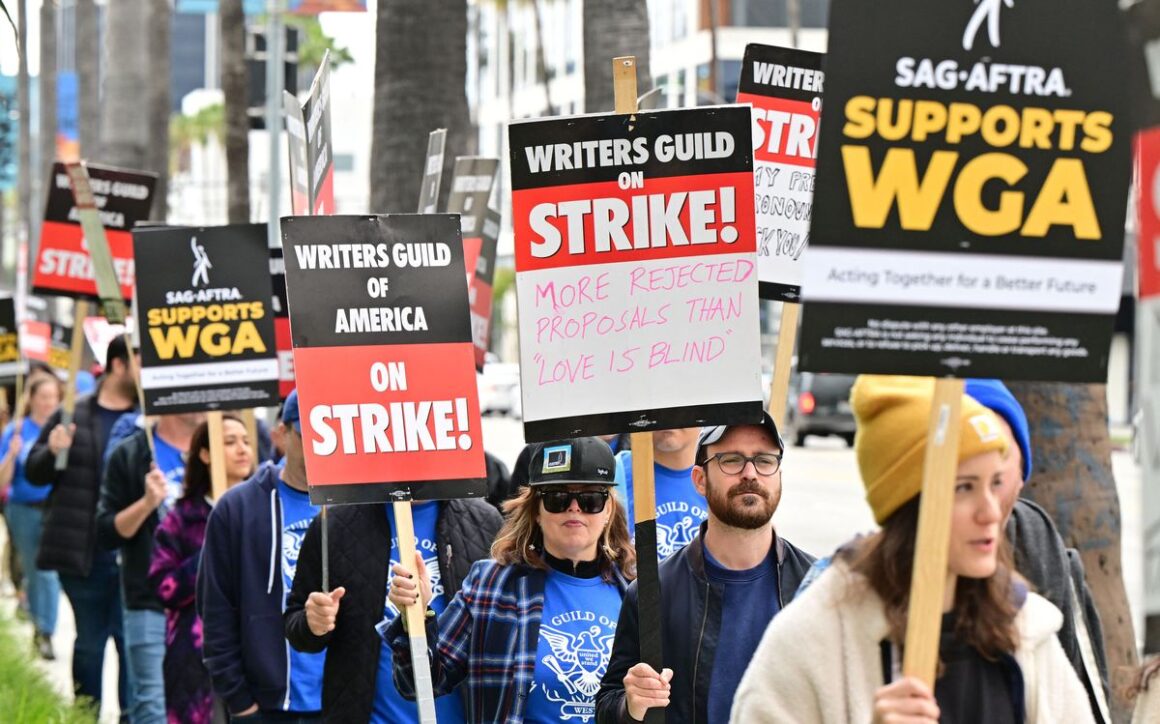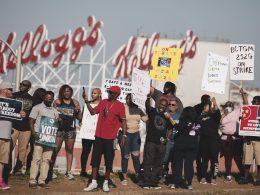By David Rhoades, Socialist Alternative (our sister organisation in the United States)
On July 13, SAG-AFTRA (Screen Actors Guild – American Federation of Television and Radio Artists), a union of 160,000 film and TV performers, joined the Writers Guild of America (WGA) on strike for the first time in 63 years.
For the writers, who’ve endured 72 days on the pickets in brutal summer heat, it is a much needed boost as studio bosses plan to starve the writers out. They’ve received periodic support from union workers of all kinds since May — teachers from UTLA, WNBA players, Teamster UPS drivers, nurses, and hotel workers are among those who’ve supported or reinforced the WGA pickets — but SAG joining the strike meant having a decisive new advantage in shutting down studio production.
As actors joined protests, the atmosphere was jubilant — picket lines at Netflix, Paramount, Warner Bros, Disney, and elsewhere were larger than they’d ever been. Well-known actors made public statements to criticize corporate greed and declare workers deserve healthcare and fair wages. Actors promoting big studio films left movie premieres the moment the strike began.
With future projects no longer in development and current projects shut down, the writers’ strike has officially become the film and TV strike.
Militant SAG membership saves the strike
SAG joining forces with WGA is the first real setback for the Alliance of Motion Picture and Television Producers (AMPTP), the alliance of 350 studios and bosses who extract tens of billions of dollars from film and TV labor every year.
In late June, AMPTP seemed to have the upper hand. WGA had successfully halted development of scripted material, but already-scripted shows and movies were chugging along. On June 23, the membership of Directors Guild of America (DGA) ratified the TA offered by the AMPTP, isolating the WGA and turning the DGA into a baton the AMPTP could use on the writers in the press.
With the DGA out of the way, the AMPTP made SAG their next target. The day after DGA ratified their TA, SAG union president Fran Drescher declared to SAG members that negotiations with the AMPTP were productive; the union’s chief negotiator, Duncan Crabtree-Ireland, said he was optimistic they’d deliver a fair deal. Two days later, leaders of both major SAG factions endorsed Drescher for another term as union president.
The membership was a different story.
SAG members, 87% of whom don’t make the $26,000 required annually to qualify for healthcare benefits, rightly believed the AMPTP would not offer what their membership would need to survive. On June 27, a letter circulated within SAG addressed to Drescher and the negotiating committee.
“A strike brings incredible hardships to so many, and no one wants it,“ the letter read. “But we are prepared to strike if it comes to that. And we are concerned by the idea that SAG-AFTRA members may be ready to make sacrifices that leadership is not.” Over 2,000 members, including top-billed and background actors alike, signed the letter.
The militant but honest criticism had its intended effect: what were once hailed as “productive talks” now needed a two-week extension, in reality a delay tactic by studios to compel actors under contract to promote major investments like Mission Impossible 7, Barbie, and Oppenheimer. Meanwhile, the AMPTP arranged for the White House to send a federal mediator in a last-ditch effort to help pressure SAG into concessions. Biden and the Democrats, eager as ever to assist corporations in shutting down a strike, obliged. But up against the desperation and determination of their membership, the negotiating committee refused to extend the deadline any further, mediator or no. AMPTP had delayed the strike, but they could do nothing to prevent actors from walking off sets and red carpets to join the writers in the fight against the studios.
Workers raise their pickets while CEOs lower their masks
Most of SAG’s demands mirror WGA’s: minimum wage increases of 11%, 4%, and 4% over the next three years, 2% of revenue generated by streaming shows, and protections from generative AI.
“There’s a level of expectation that they have that is just not realistic, “ said Disney CEO Bob Iger the day after he increased his compensation to $81 million over the next three years via a contract extension.
The studios want to pay background actors a single day’s wage to scan their faces and sign over all rights to use their likeness forever.
Background work is one of the only reliable and consistent sources of work for a film and TV actor, and it’s one of the only ways many SAG members can earn enough to get healthcare benefits. Using AI to eliminate background actor jobs would not only extract millions from working actors, but it would gut the membership of SAG.
Which workers now know is the point, thanks to a report from AMPTP mouthpiece Deadline.
“The endgame [of the strike] is to allow things to drag on until union members start losing their apartments and losing their houses,” said an unnamed studio executive to Deadline. The report, published on the final day of negotiations between SAG and AMPTP, revealed the stakes of this fight extend far beyond percentages or AI regulations: the studios planned to break the WGA permanently. This uncommonly-public admission by the studios represents the fundamental goals of all bosses in labor negotiations – the goal isn’t only to keep worker pay down to maintain profit; it’s always to undermine workers’ ability to fight back in the future, too.
The Deadline article lays bare, with rare candor, the threat wielded by every capitalist employer for centuries: “Give us your labor or we’ll starve you.” Perhaps the unnamed executive thought their statement would intimidate SAG into a deal; regardless of what they intended, it didn’t intimidate so much as enrage.
“It’s just so over-the-top, like The Grinch Who Stole Christmas over-the-top,” striking writer/producer Melody Cooper said to Socialist Alternative. “However it happened, it fueled the fire in our favor.”
The voracious greed behind what an AMPTP insider called a “cruel but necessary evil” polarized the struggle not just for the film and TV industry, but all workers in struggle: are you on the side of the people fighting for better wages and work protections? Or are you on the side of people who weaponize homelessness and deprivation?
Industry crisis created by the AMPTP
In the early 2010s, streaming companies created a new business model for film and TV that generated revenue from subscriptions rather than advertising.
Profitability for these companies depended on rapidly attracting subscribers through the licensing (and later, production) of an expanding library of movies and TV shows. The selling point for subscribers was access to an enormous, centrally located collection of shows and movies.
The benefit for streamers was no agreement existed that required residuals for streaming content. When Netflix paid to license The Office, for example, NBC received a flat fee, a percentage of which went to writers, actors, etc. in residuals. But no matter how often The Office was streamed on Netflix, writers and artists received virtually nothing.
“I get my biggest residuals for [Law & Order:] SVU, for instance, from NBC broadcast reruns and foreign,” Melody said. “It’s streamed again and again and I don’t see much of anything from that.”
Under the logic of capitalism, any source of profit inevitably attracts and creates competition. Other streaming platforms arose, each promising an exclusive library of shows and movies. When it was clear that there weren’t enough existing hit shows and movies to license, streaming platforms were forced to produce their own TV and films. As we reported in May, this required establishing new methods of production that lowered particularly writers’ wages while effectively eliminating residuals. No matter how residuals are treated moving forward, two conclusions are inescapable for workers: All actors and writers deserve a living wage. As long as studios are making money off of the past work of writers and actors, they deserve to share in that revenue.
Taking advantage of low interest rates, they borrowed against their inflated stock value to finance new productions, creating enough hits to build a profitable subscriber base. However, climbing interest rates have backed streamers into a corner. They have to keep producing or acquiring shows and films to win subscribers at an ever-shrinking rate without driving away current subscribers by sharply raising prices or introducing ads; meanwhile, the debt they’ve incurred requires repayment at a higher rate.
There’s an obvious limit to all this: there is a finite number of people in the world. Exponential profit growth on a subscriber model simply cannot sustain itself, and streaming platforms know that.
Consequently, the strike isn’t just fighting for a larger share of the profit—it’s challenging the method of production the entire film and TV industry has built itself around over the last decade.
AMPTP looks for new avenue of attack
So what’s next for the strike?
The newly established unity between SAG and WGA has created a corresponding crack in the studio alliance. While broadcast media companies like Warner Bros and Paramount temporarily united with their tech streaming rivals like Netflix and Amazon Prime, the strike is partially a result of the growing competition between studios. As the strike exerts greater pressure on each company’s bottom line, it’s possible some members of AMPTP will break ranks and seek to form side agreements with the writers and actors – SAG and WGA members should fight this and force the entirety of AMPTP to sign a strong contract. However, it’s also possible the AMPTP will regain its footing and go on the offensive.
What’s clear is that AMPTP’s plan to starve out the WGA is less viable with SAG on the pickets. AMPTP was bent on preventing SAG from joining WGA on strike because films and TV shows—particularly shows produced for streaming—take years of labor before turning a profit. Studios have to maintain a near-constant pipeline of new commodities planned years ahead of time to ensure growth. Because the unions have shut down both ends of the production pipeline, studios are looking at months of stalled projects and stagnant investments until they go back to work. For capitalism, which measures success in quarterly earnings, that’s unacceptable.
But the position of strength occupied by the WGA and SAG is only possible if the two unions act as one; practically, that means refusing any offer from the studios until the memberships of both unions approve of their respective terms. On that point, the SAG letter offers an important lesson: union leaders ultimately answer to the rank-and-file membership. A membership that puts pressure on its leaders to remain firm is a membership well-equipped to take on the bosses.
Coming this Summer: Workers striking back
In reality, there’s nothing uniquely greedy or evil about studio executives that you wouldn’t find in any boardroom or executive office. Capitalism coerces all workers into selling their labor, from delivery drivers and hotel workers to background actors and staff writers.
Our shared coercion under capitalism is why all workers share a common interest, regardless of what we do or how much we’re paid. No matter how much fame or recognition an actor or writer has, if employers can deny them the means to have food or shelter at will, they’re at the employers’ mercy.
But that coercion comes from a fundamental weakness: employers need workers in order to keep making a profit.
The logic of capitalism has always compelled employers to undermine or crush every strike, but rising living costs, the decoupling global economy, and fiercer international competition has pushed workers and bosses into more intense conflict. That’s why union leaders entering contract negotiations in 2022 and 2023 have not been able to rely on typical boss-friendly methods—the world economy has made it so piecemeal gains are not sufficient for workers to survive, nor are they possible for bosses to give up without a fight.
As of this writing, 350,000 UPS workers are likely to go on strike on August 1 in a labor action that could cost the economy $7 billion. Up to 150,000 auto workers could strike against the big three Detroit automakers when their contracts expire September 14.
While actors and writers may not appear to have much in common with UPS drivers or auto workers, they all face the same coercive forces wielded by bosses who are fighting to protect and increase their billions in profits. Workers should find their common demands like Medicare for All, national rent control, or a $30 minimum wage to build combined pickets, rallies, and national protests to show that workers can fight back as a class and no longer be separated by industry or workplace.












